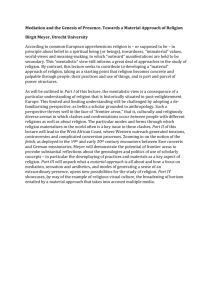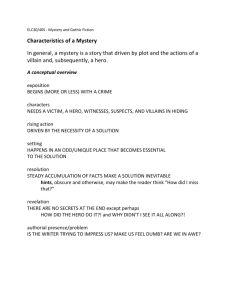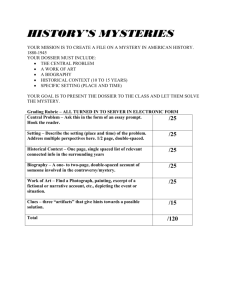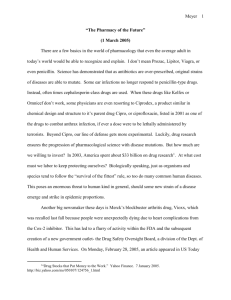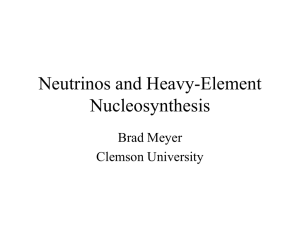Notes - John Provost
advertisement
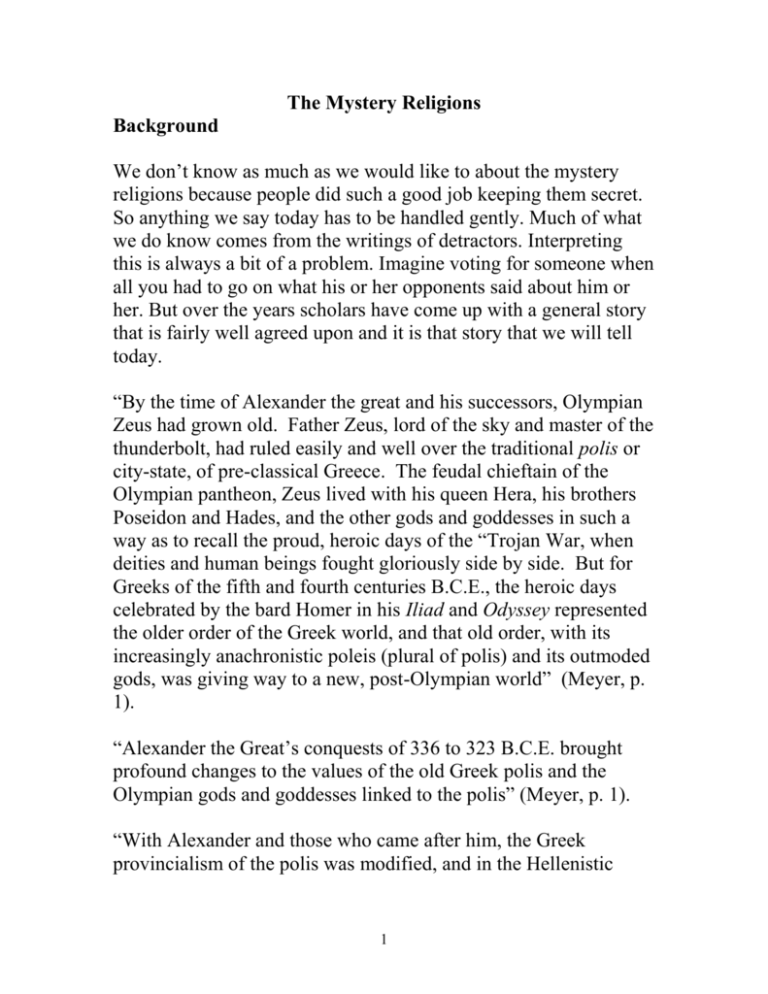
The Mystery Religions Background We don’t know as much as we would like to about the mystery religions because people did such a good job keeping them secret. So anything we say today has to be handled gently. Much of what we do know comes from the writings of detractors. Interpreting this is always a bit of a problem. Imagine voting for someone when all you had to go on what his or her opponents said about him or her. But over the years scholars have come up with a general story that is fairly well agreed upon and it is that story that we will tell today. “By the time of Alexander the great and his successors, Olympian Zeus had grown old. Father Zeus, lord of the sky and master of the thunderbolt, had ruled easily and well over the traditional polis or city-state, of pre-classical Greece. The feudal chieftain of the Olympian pantheon, Zeus lived with his queen Hera, his brothers Poseidon and Hades, and the other gods and goddesses in such a way as to recall the proud, heroic days of the “Trojan War, when deities and human beings fought gloriously side by side. But for Greeks of the fifth and fourth centuries B.C.E., the heroic days celebrated by the bard Homer in his Iliad and Odyssey represented the older order of the Greek world, and that old order, with its increasingly anachronistic poleis (plural of polis) and its outmoded gods, was giving way to a new, post-Olympian world” (Meyer, p. 1). “Alexander the Great’s conquests of 336 to 323 B.C.E. brought profound changes to the values of the old Greek polis and the Olympian gods and goddesses linked to the polis” (Meyer, p. 1). “With Alexander and those who came after him, the Greek provincialism of the polis was modified, and in the Hellenistic 1 period there emerged a new sense of the ‘inhabited’ world, as the international stage for human action” (Meyer, p. 2). “Doubts had been cast upon the Olympian deities of the Greek polis, however, long before the time of Alexander the Great. In the world of fifth-century Greece, philosophers and playwrights already questioned the virtues and, implicitly, the existence of gods and goddesses who were portrayed, with anthropomorphic vividness, as lustful, jealous, malevolent immortals. The critics demanded to know how one could worship a god like Zeus. According to the Greek myths, Zeus dethroned his titanic father Kronos, pursued and ravished, often while in bestial disguise, many a beautiful woman, and resorted to countless stratagems in order to evade his suspicious wife Hera. Such behavior on the part of the Olympians raised serious theological doubts in the minds of the more reflective Greeks” (Meyer, p. 2). “In sum, the Olympians began to fall from glory for several reasons. Their destiny was linked to that of the Greek polis, which was no longer the basic political unit in the world after Alexander’s time. Furthermore, the philosophical criticism of religion that took place before and during the Hellenistic period challenged Greek beliefs and exposed the gods as unworthy of the worship and devotion of thoughtful Greek people. To be sure, the Olympian pantheon maintained itself as a religious and cultural force in the Hellenistic world, and attempts were made to inject new philosophical and religious values into the systems of the Olympian deities. Homer did not relinquish his place at the center of ancient education, and the allegorical exegesis of Homeric texts allowed people to interpret the sacred myths in new, scientific, philosophical ways. Nonetheless, the hearts of many were turning away from Zeus and the Olympians during this period, and many searched at home and abroad for gods that would satisfy more fully their religious longings” (Meyer, p. 3). 2 “One type of religion, the so-called ‘mysteries,’ flourished during the Hellenistic period and proved very popular among people seeking new and more satisfying religious experiences” (Meyer, p. 3). “The mysteries were secret religious groups composed of individuals who decided, through personal choice, to be initiated into the profound realities of one deity or another. Unlike the official religions, in which a person was expected to show outward, public allegiance to the local gods of the polis or the state, the mysteries emphasized an inwardness and privacy of worship within closed groups. The person who chose to be initiated joined an association of people united in their quest for personal salvation” (Meyer, p. 4). “The word mystery (mysterion in Greek) derives from the Greek verb myein, ‘to close,’ referring to the closing of the lips or the eyes. This ‘closed’ character of the mysteries may be interpreted in two ways. First of all, an initiate, or mystes (plural, mystai) into the mysterion was required to keep his or her lips closed and not divulge the secret that was revealed at the private ceremony. Vows of silence were meant to ensure that the initiate would keep the holy secret from being revealed to outsiders. Most mystai observed their pledge of secrecy, and as a result we possess little information about the central features of the mysteries” (Meyer, p. 4). “A second way to interpret the ‘closed’ nature of the mysteries relates to the closing and the opening of the eyes. Closed eyes brought darkness to the prospective initiate both literally and metaphorically, and the opening of the eyes was an act of enlightenment. Just as one of a baby’s first responses to the world is the discov3ery of light through the opening of the eyes, so the initiate, sometimes described as one reborn, also saw the light. Nocturnal initiatory ceremonies, with flickering torches 3 accentuating the contrast between light and darkness, made the primal experience of enlightenment that much more vivid to the eyes and the emotions” (Meyer, pp. 4-5). “One of the priests in the mysteries was termed a hierophant (hierophants), ‘one who shows sacred things.’ The highest stage of initiation in the Eleusinian mysteries is that of epopteia, ‘beholding,’ and an initiate into the great mysteries was called an epoptes, ‘beholder’” (Meyer, p. 5). “Blessed is one who goes under the earth after seeing these things. That person knows the end of life, and knows its Zeus-given beginning” (Meyer, p. 5). “Many of the mystery religions were of great antiquity, and their origins are hidden in the mists of prehistory. Some of the mysteries seem to have developed from agrarian festivals that celebrated the fertility of nature as it manifested itself in the life cycle of crops” (Meyer, p. 5). “This ancient heritage of the agrarian festivals may help explain the prominent place of goddesses in the mystery religions of the Hellenistic world. Through these early agricultural festivals, worshipers expressed concern for the fertility of the earth and are thought to have confessed the earth to be nourished and protected by the divine Mother. It has often been supposed that in some of the earliest religions in human history, the mother goddess reigned alone or nearly alone and embodied the mysterious forces of life and death in the world” (Meyer, p. 6). “The development of early agrarian or fertility festivals into the mystery religions involved, first and foremost, the conviction on the part of the worshipers that the cycle of nature related directly to human life. Plants and animals participated in a cycle of death and life, and so also did human beings. Death came to all the divine 4 forces of nature - Kore, Dionysus, Adonis, Attis, Osiris, the Mithraic bull - but finally life was victorious. Kore returned from the realm of Hades; Dionysus vivified his devotees; Adonis rose from the dead; Attis gave an intimation of new life; Osiris reigned as king of the underworld; and the bull provided life for the world. Hence, if human beings could assimilate the power that made life triumphant in the world of nature, they too might live in a more complete way” (Meyer, pp. 7-8). “Just how the initiates into the mysteries appropriated this power we do not know, but they may have understood themselves to have experienced an immediate or mystical encounter with the divine. At times this experience seems to have entailed an approach to death and a return to life. Sometimes, as in the Eleusinian and Egyptian mysteries, the mystai underwent dramatic rituals of darkness and death and emerged afterward into new light and life. In several texts the initiates are specifically declared to be reborn” (Meyer, p. 8). “Ordinarily the mystai partook of food and drink in the ritual celebrations, and sometimes they may have become one with the divine by participating in a sacramental meal analogous to the Christian Eucharist” (Meyer, p. 8). “The experience of death is compared with initiation into great mysteries. Plutarch initially notes the similarity of the Greek verbs teleutan (to die) and teleisthai (to be initiated) and then observes that people who die and people who are initiated go through comparable transformations” (Meyer, p. 8). “Whatever else the mystery religions were, they were fascinating and delightful occasions for the participants” (Meyer, p. 9). “Several …sources describe in detail the public celebrations that preceded the secret ceremonies. A colorful band of people 5 marched together in the parades and processions that took place during the holidays observed for the mystery religions. Some mystai sang and danced, others displayed unusual and sometimes bizarre attire, while dignitaries carried the holy shrines or sacred paraphernalia of the deities featured in the mysteries. As portrayed by ancient authors, the processions in honor of the Magna Mater and Isis were carnivals that would rival modern celebrations of Mardi Gras” (Meyer, pp. 9-10). “Other rituals preliminary to the secret initiations were less spectacular but equally stirring to those taking part. These observances included such rites of purification as fasting, abstaining from specified foods (such as meat or wine), refraining from sexual intercourse, and submitting to cleansings” (Meyer, p. 10). “The secret ceremonies of the mystery religions, however, remain largely hidden from us. We know that the purified devotees, properly attired according to the regulations for a given mystery religion, assembled at a holy site for the rituals of initiation. In the Eleusinian mysteries the mystai participated in rites that incorporated three types of sacred observances: legomena, ‘things recited,’ deiknymena, ‘things shown,’ and dromena, ‘things performed” (Meyer, p. 10). “A fragment of Aristotle provides the occasion for a final word on the ancient mystery religions. In this fragment Aristotle concludes that initiates into the mysteries do not learn anything (ou mathein ti), but rather have an experience (pathein) and are put in a certain state of mind (diatethenai)” (Meyer, p. 12). “They were not given instruction or taught doctrine in any traditional sense. Initiation was not classroom education, but an eye-opening experience that transcended earthly realities and mundane learning. Just as any mystical experience ultimately 6 cannot be put into words or described adequately in books, so also the blessed mystai heard, saw, and performed the ineffable. They claimed to have tasted death and life and to have been touched by the divine. United with one or another of the deities of the mystery religions - including, some scholars would say, Christ - they beheld the light, and their lives were renewed” (Meyer, pp. 12-13). 7


